Fort Sumter – Symbol of Hope or Symbol of Hate?
Even though I am a Canadian, I have always been fascinated by the story of the American Civil War and the lessons, learned and unlearned, that came out of that conflict. Estimates of the war dead have always been difficult, but there is no doubt that at least 620,000 men died from wounds, disease or as prisoners of war. Some recent studies put the numbers as high as 850,000. No matter which figure you choose, the fact is that more men died fighting each other on American soil than in all foreign wars combined. It was a slaughter on a scale that had never been witnessed before in the history of warfare and it all started only a few miles from where I am standing in Charleston, South Carolina when the first artillery shells were fired at Federal troops inside Fort Sumter. Won’t you join Alison and me as we venture there and try to absorb and understand why brother turned against brother in this most American of wars? Given the current divisions in American politics and the very nasty undertones that have arisen, I think it’s more important than ever to try to get a grip on the past so that it does not repeat as the future.
History of Fort Sumter
To a certain extent you can thank the Canadians, or at least the British, for the construction of Fort Sumter. During the War of 1812 the Americans learned how vulnerable their coastal cities were to attacks from the sea and afterwards constructed a series of forts from Maine to Louisiana. Construction of Fort Sumter began in 1829 and was still not finished by the time South Carolina became the first state to secede from the union in December, 1860. Still what was there was pretty impressive as you can see from this model of what Fort Sumter looked like when the war broke out.
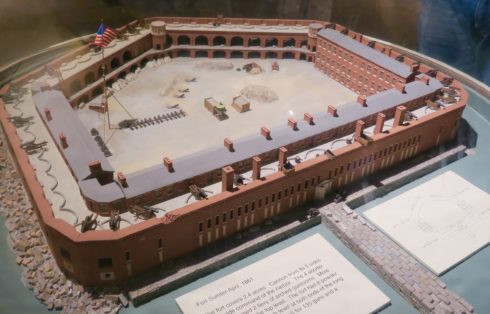
The structure is essentially a pentagon, built upon an artificial island at the end of a sand bar at the mouth of Charleston Harbor. Its walls were 50 feet high and five feet thick with 135 guns designed to make sure no boats could get past it and threaten the city. Fort Sumter is the red dot right at the mouth of the harbor. While it appears that you could pass it on either side, in reality it’s only passable to the north, the south side being a long sand bar connecting to Morris Island. You can also see that Fort Sumter is only one of many harbor fortifications protecting Charleston Harbor. That was a very important factor in the two battles to take the fort, first by the South and then by the North.
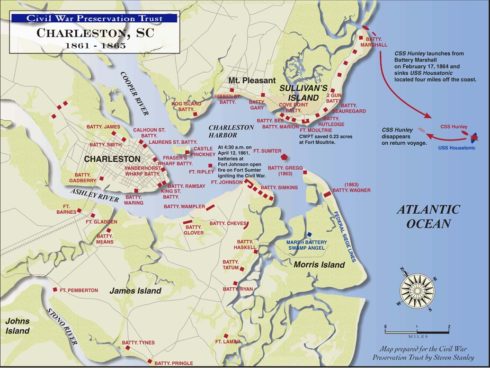
If you are like most people, including myself, your image of Fort Sumter is only as the place where the Civil War began; a few shots were fired, the fort surrendered and that was it, the war was on. That’s only a fraction of the story as I was about to learn. Fort Sumter became a symbol for both sides of the war. To the North it was not only the place where the war started, but where they wanted it to end. The recapture of Fort Sumter took on an importance that far out weighed its strategic value and the North put an inordinate amount of resources into that effort. To the South it was the opposite. Fort Sumter was the first place ‘liberated’ during the war and as determined as the Union was to retake it, the South was just as determined to hold it. They too placed a value on Fort Sumter that far out weighed its usefulness to the Confederacy. In a way you can look at Fort Sumter as a microcosm of the entire war. Two sides battering each other head on and entirely losing sight of reason. It was all for ‘the cause’ and yet the vast majority of Confederate soldiers were not slave owners and couldn’t afford slaves even if they wanted them. On the Union side there were no doubt some idealists who fought for abolition, but most ordinary soldiers were just as racist as their southern brothers.
Visiting Fort Sumter
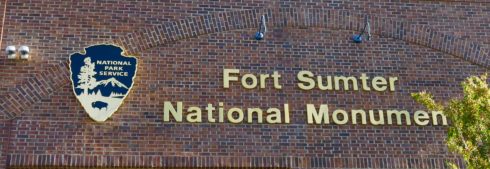
Fort Sumter is a National Historic Monument administered by the National Park Service. The monument consists of the interpretive centre at Liberty Square in Charleston and the actual fort at the mouth of the harbor which is only accessible by boat. The Park Service operates a ferry service to Fort Sumter that departs Liberty Square three times a day from March through November and twice a day in winter. Tickets cost $24.00nfor adults, $22 for seniors and $16 for children. You can buy tickets ahead of time here. The stop at Fort Sumter lasts just over an hour which is just about the right amount of time to explore the place. Even if there wasn’t a stop at Fort Sumter, the ferry trip is a nice way to see the Charleston skyline with its many church spires. OK, so let’s get going.
There’s no charge to visit the interpretive centre and even if you don’t have the time to go out to Fort Sumter, I strongly suggest you drop in to see the exhibits here. I couldn’t help but notice that about half the NPS employees at Fort Sumter National Monument are black. I also learned a lot as we waited for our allotted departure time, including this.
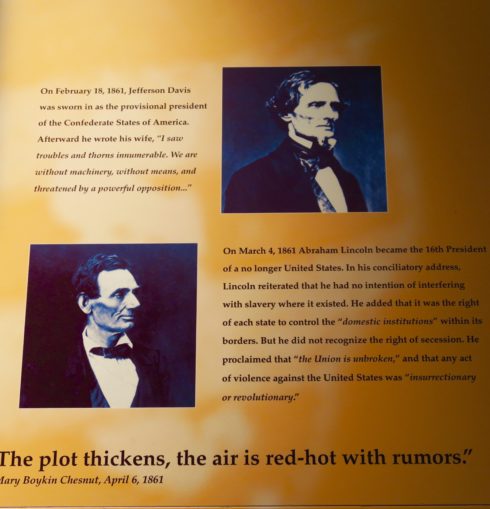
Did you know that Jefferson Davis was the President of the Confederacy before Abraham Lincoln was inaugurated? He was in office for over two weeks before Lincoln was sworn in on March 4, 1861. Lincoln, the first Republican President, won the election in November, 1860 with 40% of the popular vote. The Democratic Party had split in two with Stephen Douglas running in the north and John Breckenridge in the south. Between them they had close to 50% of the popular vote. The election results led to the secession of South Carolina on December 20, 1860. By the time Lincoln was inaugurated seven states had joined the Confederacy with Davis as President. Interestingly, Virginia was not one of those states. It did not secede until after the war began.
After South Carolina seceded the state militia moved to occupy most of the coastal defences around Charleston. Federal forces under Major Robert Anderson evacuated Fort Moultrie on the mainland and moved to Fort Sumter. An effort to land more troops and resupply the fort by the ship Star of the West was repulsed by shots fired by the cadets from The Citadel military academy. In reality these were the first shots fired during the Civil War, but possibly because it happened before Lincoln was President, this incident was largely overlooked.
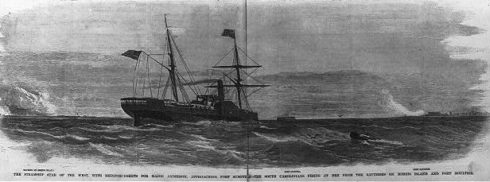
After Lincoln was inaugurated, he made it clear that he would not give up on resupplying Fort Sumter. This prompted General P.G.T. Beauregard (what a name!), to demand the surrender of the fort. Anderson refused and the fort was shelled on April 12, 1861 marking the official beginning of the Civil War. On April 13 Anderson surrendered. Despite 3,000 shells being fired at Fort Sumter, not a single defender was killed. And so ends the usual story of Fort Sumter. In reality it was only beginning. Let’s get on the boat.
Getting There
This is the Spirit of the Low Country the faux sidewheeler that will take us to Fort Sumter which you can just make it out on the waterline on the right edge of the picture.
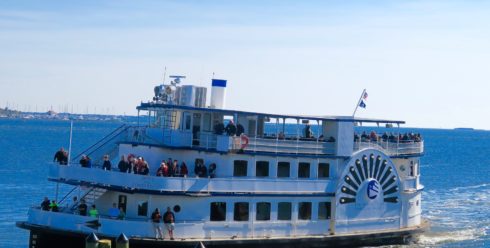
As I mentioned there’s lots to see on the way out including the beautiful Arthur Ravenel Jr. Bridge across the Cooper River.
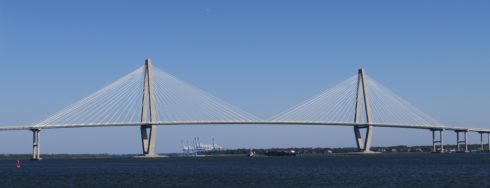
And the retired aircraft carrier U.S.S. Yorktown which served in WWII, Korea, Vietnam and as the recovery vessel for the Apollo 8 mission. She still looks in fighting trim. You can take a tour on a visit to Patriot’s Point on the other side of the harbor.
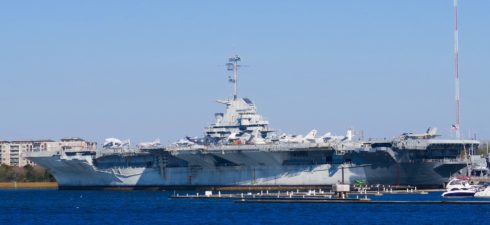
This is Castle Pinckney, another of the Charleston Harbor fortifications that you pass on the way to Fort Sumter.
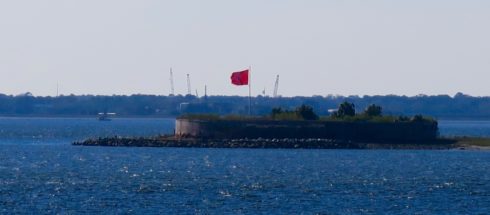
And then we’re here. The boat you see is the sister vessel to the Spirit of the Low Country. As one vessel arrives, the other leaves.
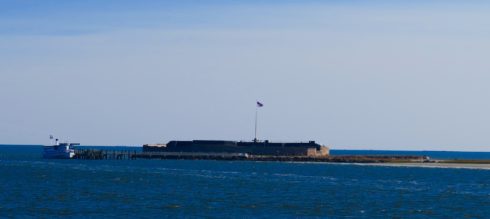
The first thing you might notice about Fort Sumter today is that it doesn’t look anything like the model of the fort as it existed in 1861. That’s because the Union forces returned in 1863 to begin the longest siege of the Civil War. This is the battle of Fort Sumter that you don’t hear much about even though it involved far more men, casualties and effort. This was when Fort Sumter became a symbol for both sides.
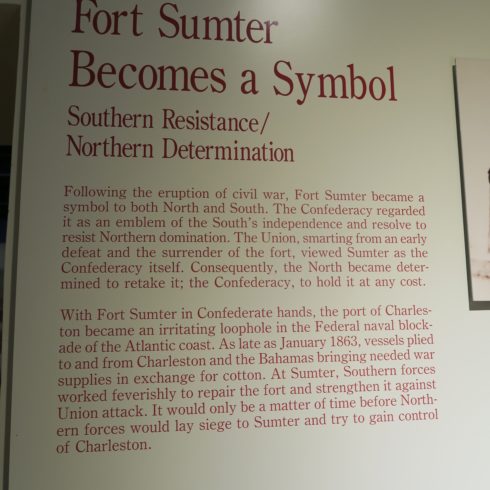
On Fort Sumter
As I mentioned, you get just over an hour on Fort Sumter which is enough time to see the three main elements – the interior, the exterior and the museum/gift shop.
After taking the obligatory, I was at Fort Sumter photo, you enter through a portal and can either follow a park ranger around to get the story of the siege of Fort Sumter or do it yourself with the help of lots of interpretive signs.
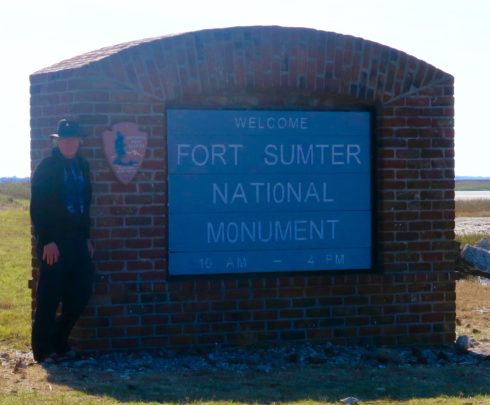
Long story short, the Union siege began in April 1863 and didn’t end until February, 1865 after 50,000 artillery shells basically levelled the place. This is what it looked like in April, 1865 when Major Anderson returned four years after his surrender to raise the American flag once again.
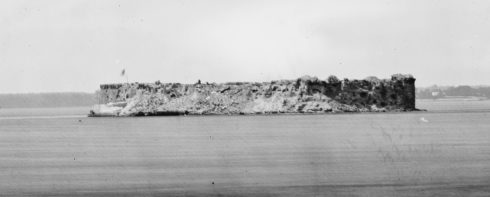
To this day there are still places where unexploded shells are lodged in the walls. I presume they have been neutralized.
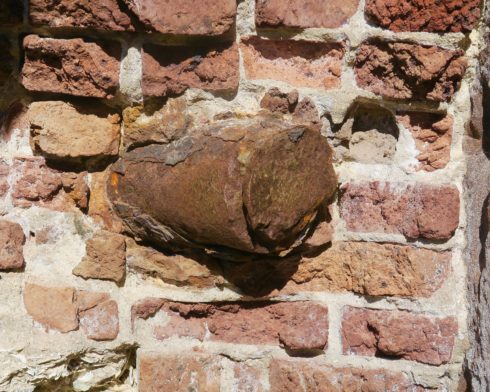
This is the interior.
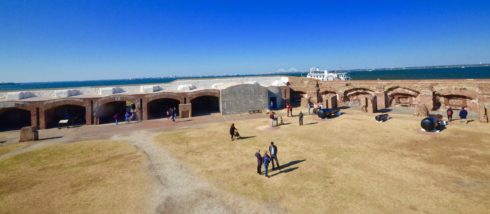
Not really that much to look at, except for some interesting artillery pieces. This is Alison posing alongside a 15 inch Rodman cannon that was typical of the heavy artillery used to protect the American coastal forts at the outbreak of the war. It took twelve men to man it and all of them were cast at foundries in the north.
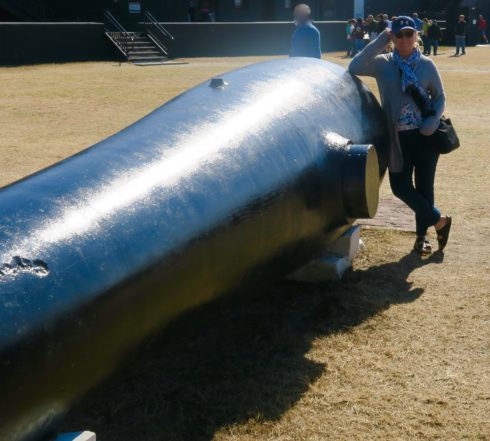
Almost all of the artillery pieces at Fort Sumter have been kept in tip top condition including this freshly painted columbiad. Columbiads were smooth bore cannon used to fire projectiles over what were considered incredible distances at the time. So incredible that former civil war gunners used a massive columbiad as the mechanism for putting men on the moon in Jules Verne’s wonderfully prophetic From the Earth to the Moon.
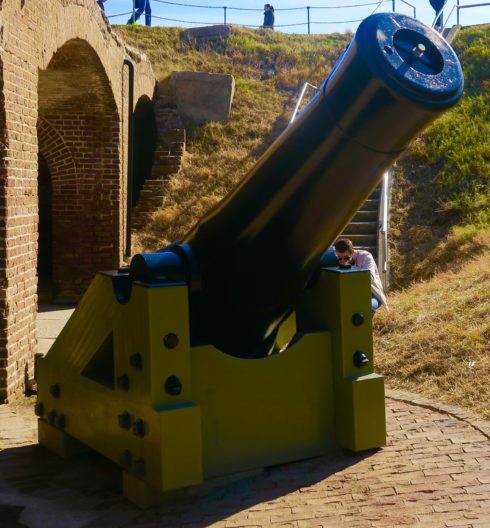
This is the view looking towards the mouth of Charleston Harbour with Sullivan’s Island and Fort Moultrie visible to the left.
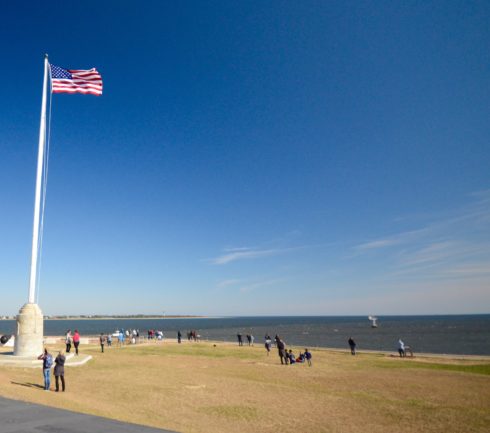
The museum has a number of interesting exhibits, although most are a reprise of the exhibits at Liberty Square. I found this one the most interesting.
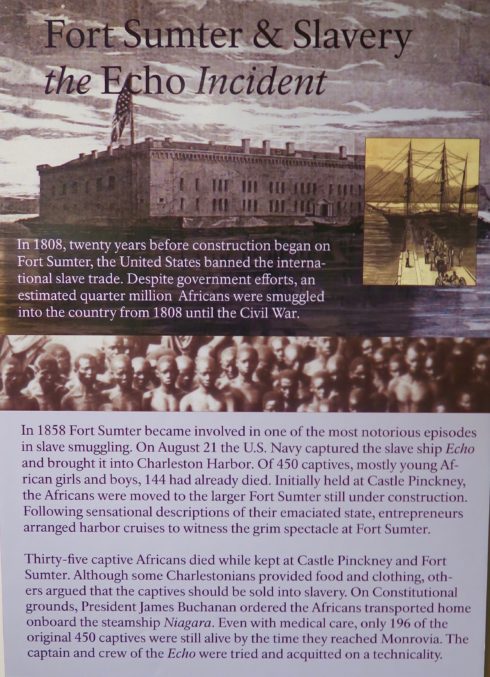
Here is a link to the trial of the crew of The Echo and the reasons why no one was convicted. It has eerie similarities to many trials that have taken place in the late 20th and early 21st centuries where white policemen and civilians have, despite the seemingly overwhelming evidence against them, walked free from murder charges because a white jury simply would not convict. Not ten miles as the crow flies, from where I am standing reading this history, an absolutely unrepentant Dylann Roof is sentenced to death for murdering nine black people worshipping in a church. Murders so shocking and unprovoked that it at last prompted the removal of the Stars and Bars from the state capitol. It is over one hundred and fifty years since The Echo incident and for many, nothing has changed. In fact, being in the states after the election of Donald Trump, I am sad to say that I have seen more rebel flags sported from windows and from pickups than I’ve ever seen. One of the most chilling sights to me is seeing a young white male in a big pickup with a Trump/Pence Make America Great Again flag on one side and the rebel flag on the other. He’s a racist bigot and he doesn’t give a damn who knows it. Thanks Donald.
The last thing you see as you exit the museum on Fort Sumter is also a flag. It’s behind plexiglass so not easy to photo. This is the very flag that Major Anderson was allowed to take down from Fort Sumter on April 14, 1861, the day after the surrender.
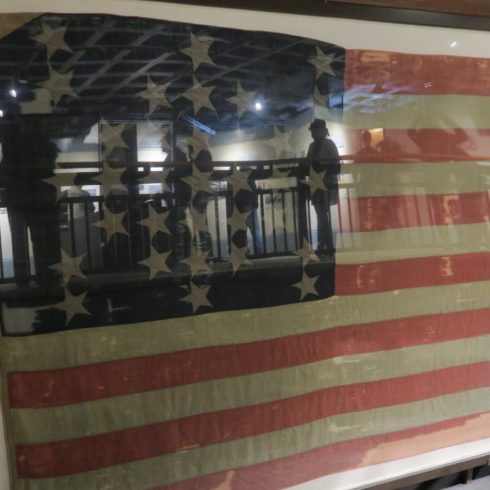
Four years to the day later, Major Anderson returned to Fort Sumter and once more raised the Stars and Stripes over the island. A few hours later, Abraham Lincoln was assassinated in Washington.
It’s not a coincidence that I am writing this post just two days before the inauguration of Donald Trump. Fort Sumter was an important symbol for both sides in the Civil War. Symbols are powerful tools that can be used for good or evil, but they are only symbols and they accomplish nothing on their own. Make America Great Again is the symbol of hope for those who voted for Trump and a symbol of boding evil for those who fear what he stands for (if anything). I can only hope that it does not become a new rallying cry that will lead to results as catastrophic as those first shots fired at Fort Sumter.
Updating this post four years later as Trump rails against his loss by over 7 million votes, I fear that my presentiments about him have come true and the United States is as divided as it has been since the start of the Civil War.
However, South Carolina remains a beautiful state to visit as you can read in these posts on Huntington Beach State Park, Brookgreen Gardens and Oconee County. It’s also famed for its golf courses, three of which I played on a visit to Myrtle Beach just before coming to Charleston.
Next I’ll be heading to Florida via Georgia where I’ll stop at an obscure place where the Civil War ended for one man. Join me at Jefferson Davis Historic Site in Irwinville, Georgia to see where the Confederate President was captured.

